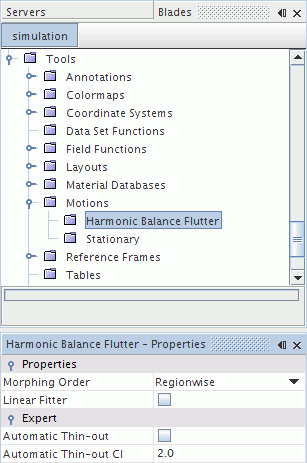| Morphing Order
|
The morpher can operate in two different modes: one region at a time, or one motion at a time. This property selects the mode to use.
|
|
Regionwise
|
Each region that is associated with this motion is morphed independently, one region at a time. This option is used, for example, in a fluid-solid case, where the solid region has a solid displacement motion and the fluid region has a morphing motion.
|
|
Motionwise
|
All regions that are associated with this motion are morphed at the same time. This option is recommended for use in cases where internal inter faces are present between regions, if the floating morpher boundary method is applied to the boundaries on either side of the interface, and both regions are set to use the same morphing motion.
|
| Linear Fitter
|
This option extracts a linear transformation from the prescribed motion, and uses this transformation to move vertices outside of the main morpher. Any remaining motion is treated using the multiquadric procedure as usual. If the linear part constitutes most the motion and the deformation part is small, the main morpher is expected to perform more robustly if the Morph From Zero property is enabled on the Morpher solver.
|
|
Activated
|
Linear motion is treated separately from multiquadric interpolation.
|
|
Deactivated
|
All motion is treated in multiquadric interpolation.
|
